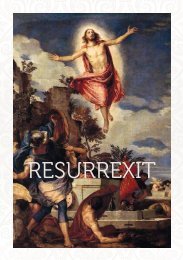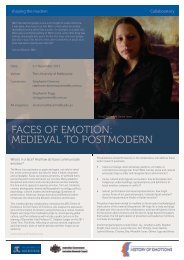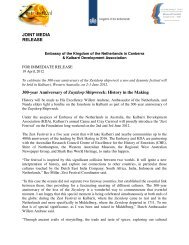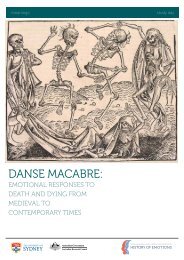Download our K-12 education pack - ARC Centre of Excellence for ...
Download our K-12 education pack - ARC Centre of Excellence for ...
Download our K-12 education pack - ARC Centre of Excellence for ...
Create successful ePaper yourself
Turn your PDF publications into a flip-book with our unique Google optimized e-Paper software.
stories <strong>for</strong> teachers & students 2013<br />
Supporting Res<strong>our</strong>ces<br />
Dutch Lives in the World<br />
story by pr<strong>of</strong>essor yasmin haskell<br />
A Latin Storm in a Dutch Teacup.<br />
What do Dutch buildings tell us about their creators, their<br />
motivations, aspirations and experiences During the Golden<br />
Age, many people seem to have reconciled their new-found<br />
wealth by leaving it when they died to various charities<br />
<strong>for</strong> the poor and needy, young and old, in society. These were<br />
particularly common in North and South Holland, the two richest<br />
provinces in the nation, where we still find a range <strong>of</strong> buildings<br />
that operated as orphanages, old peoples’ homes and as<br />
almshouses (homes <strong>for</strong> the poor). Both men and women<br />
left their own homes or arranged to buy properties to establish<br />
such almshouses where poor (usually old or widowed) men or<br />
women could go to live and be provided with food and shelter.<br />
Many <strong>of</strong> the buildings were designed to have a series <strong>of</strong> rooms<br />
around a little shared, internal c<strong>our</strong>tyard called a h<strong>of</strong>je. Some<br />
are still functioning today just as their owners set out in their<br />
foundation documents.<br />
Certainly these benefactors were acting <strong>for</strong> the care <strong>of</strong> their local<br />
community, but <strong>of</strong>ten they also had one eye on creating public<br />
memory <strong>for</strong> themselves. In Haarlem, Het H<strong>of</strong>je van Guurtje de<br />
Waal was founded in 1616 by Guerte Jansdochter de Wael, the<br />
daughter <strong>of</strong> a rich textile merchant whose family coat-<strong>of</strong>-arms<br />
can still be seen above the stone gate <strong>of</strong> the complex. It was<br />
quite a curious image too – showing the Dutch Lion with its head<br />
cut <strong>of</strong>f and blood spurting out! In Alkmaar, Margaretha van<br />
Splinter left a set <strong>of</strong> eight almshouses in 1646 which you can still<br />
see on the Lindengracht today.<br />
Rules <strong>for</strong> entrants could be quite strict and if you wanted to live<br />
there, they had to be carefully followed. Most had places only<br />
available to those <strong>of</strong> a particular faith. All expected their<br />
residents to lead a good and sober life. In 1667, the rich<br />
Amsterdam merchant Pieter Jansz Suuykerh<strong>of</strong>f left money in his<br />
will to create a home <strong>for</strong> ‘modest daughters and widows <strong>of</strong><br />
Protestant households’. The women were required to be honest<br />
and decent, and to have a ‘peace-loving hum<strong>our</strong>’ in order to get<br />
on with others in the community. In exchange, they would receive<br />
free rent, 10 pounds <strong>of</strong> rice, a keg <strong>of</strong> butter, 20 tonnes <strong>of</strong> peat (<strong>for</strong><br />
burning to keep warm) and even a little pocket money.<br />
Founders were not above leaving more obvious references to<br />
themselves and their feelings than just their names and coats<strong>of</strong>-arms.<br />
In Haarlem, one donor’s almshouse includes a poem<br />
on the main building that called on others to follow his lead:<br />
‘Wouterus van Oorschot shows his love here <strong>for</strong> the poor and as<br />
an example to the rich; died 19 March 1768.’ In Utrecht, on the<br />
Nieuwegracht, stands a row <strong>of</strong> mid-seventeenth century free<br />
houses, designed to accommodate the city’s poor and needy<br />
citizens. These were built on the commission <strong>of</strong> a wealthy widow,<br />
Maria van Pallaes. Above the entrance door a dedicatory stone<br />
highlights her motivations: ‘Not in appreciation <strong>of</strong> earthly fav<strong>our</strong>,<br />
but a place in heaven’s c<strong>our</strong>t’. Was she really thinking <strong>of</strong> the poor,<br />
or <strong>of</strong> her own salvation in making such a statement<br />
Image/ Johannes Wassenbergh, engraver Jan Caspar Philips, Portrait <strong>of</strong> Clara<br />
Feyoena van Sytzama. 1745.<br />
In ways like this, through buildings that still bear their names<br />
and their signage or continue to follow their instructions, wealthy<br />
individuals could make sure that they were remembered in their<br />
home towns. Certainly these rich citizens wanted to help the<br />
needy <strong>of</strong> their community, and many benefited from their care<br />
and concern, but these donors also wrote themselves into their<br />
towns’ histories, actvities and memories in ways that are still<br />
strong today.<br />
FAR FROM HOME: ADVENTURES, TREKS, EXILES & MIGRATION<br />
69












